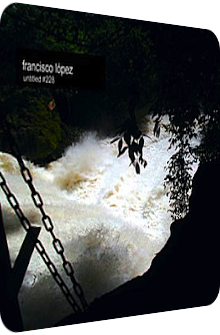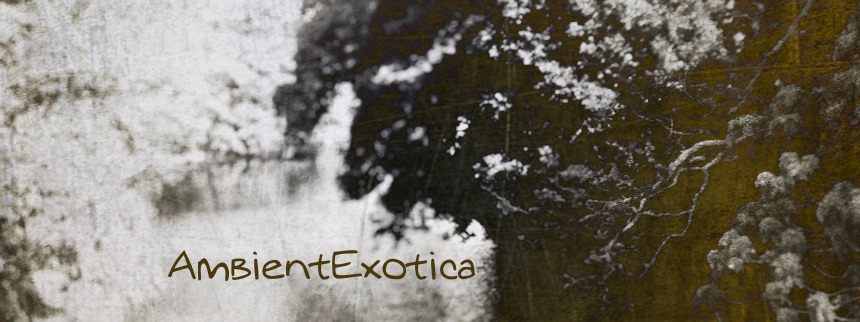
Francisco López
Untitled #228
2009
Untitled #228 is, at first glance, simply another field recording-focused but heavily processed LP by Madrid-based sound artist Francisco López. And in a way he gives the fans exactly what they expect: drone-fueled, machine-like settings interspersed with natural sounds and distant voices. And yet does this particular untitled work of 2009, released on the Ini Itu label and limited to 250 numbered vinyl versions, feature three intriguing standout concepts: for one, all sounds of the two 20+ minutes long arrangements were recorded in Indonesia, so the exotic, foreign flavor is undoubtedly perceptible in each minute. Secondly, it is not Francisco López himself who recorded these sounds, but the Indonesian Makassar-based sound collector Blindhæð. These particles and vignettes thus don't sound all too alienating for Blindhæð, as he is used to the atmosphere and knows where to catch the interesting sounds and what to expect at the unnamed locations his field recordings derive from. Thirdly, it is the task of López to assemble, filter and alter the hell out of the provided material; his status as a producer, curator, selector or creative engineer is therefore specifically emphasized. The presented material is traversed by drones as expected, but it is unclear whether the splutters and fizzles were originally present in the respective locations or whether they have been added at a later point by López. These thoughts aren't important in the end, but they explicate the synergetic nature of Blindhæð the provider, and López the producer.
Side A launches with the first Indonesian collection of field recordings taken by Blindhæð, and it sure enough does not start in the way the listener expects. Whatever he or she might presume, the Spanish producer probably neglects it, for López’s work is as iridescent as it is darkly bubbling. But here, the artist decides to use a shawm-heavy big band performance as transmitted by an Indonesian radio station. Their muffled, warbled and wonky sound seems to transport the swinging 60’s, but remains too weird and warped to ever inject the originally intended warmth of this unknown arrangement. The next phase launches after one minute already, introducing the chopped tremolo of a deep radiator-esque machine adjacent to fragile clicks and an abyssal drone layer. Male and female service announcements as well as blurred scents of melodies are interwoven. Did this scenery take place in a public transportation vehicle? The echo of the woman’s voice suggests a large train station or airport. Glistening galactic wind chimes and a downward spiraling alto flute loop are placed in-between the bustling but strangely enchanting gallimaufry. And the liveliness increases, as Blindhæð moves right into the melting pot of several people and buzzing cowbells, while López is adding static noises of a seemingly defunct radio transmitter. Tribal drums are intertwined and boost the exotic feeling further. The third phase of side A consists of a moment of tranquility when the cowbells/wind chimes cling and plink in light rain until a pesky mosquito flies around the listener's head. The fourth phase is machine-like yet again, with the sounds of airplanes passing by. Since this passage is quite rich in high frequency tones, it is a bit frantic, but never too harsh. The fifth phase presents an ebullient, effervescent maelstrom of conflating machine clangs and creaks, but it’s an unexpectedly enthralling example of snugness which finishes with an encore of the mosquito. Francisco López assembles the many field recordings of Blindhæð in his usual way, creating a mélange of dynamic locations mixed with tranquilizing moments of calmness. Never is there a moment where things go over the top, are too loud, crazy or baneful.
Side B begins with the performance of a so-called gamelan, a traditional Indonesian ensemble that plays bronze percussion instruments. Belly-massaging drones, pouring rain or related crackles in the distance together with hauntingly gelid gong sweeps in the background widen the perceptible room of the mix. It’s a gloomy Dark Ambient opening, and the enormously deep drones almost swallow the spectral bells. They don’t sound like normal gongs, but oscillate many times due to their several seconds long sustain and reverberation. After three minutes, new layers are introduced and rev the eeriness up: a concoction of portentous strings and brazen crackles is now adamantly in place, all the while the bass drone is resurrected every so often. Their tonality shifts into higher regions, their volume grows, and the wafting screeches reach a climax that is utterly encapsulating, spine-tingling and bone-crushing at the same time. A very intimidating listening experience, completely out of this world, strongly transcendental, as if the listener takes part in an arcane ritual. And so the screeching drones or strings grow higher and higher until they reach dimensions that don’t reveal the original source to the human ear anymore. It could be swarms of cicadas. Or a train braking at the station. In any way, this 22 minutes long vignette is a blast. The focus on one event stands in strong contrast to the six phases or sections of side A, and since it is much more harmonious in its setting, as the listener never moves but takes a sitting position, this tune is much more about the performance than an exciting walk through locations filled with people.
The offered material on Untitled #228 depicts the two major ways of their presentation. Generally, an artist can firstly create a time lapse as López does on side A, where six distinct phases and different places can be distilled. Movement, motion, rest and observation are the main ingredients, and sure enough do incidental chances and coincidences play an important role as well, though I believe that you can rule them out most of the time, for Blindhæð is an artist based in Indonesia and probably didn't view the respective locations with the rose-tinted glasses of a tourist, but with the watchful eye of a guy in the know. The other major possibility is to record an incident and largely present it as it happened, without any time lapse. This is mostly the case on side B, when the celebratory performance of gamelan musicians takes place. Naturally, López added both the drones and a tone pitch to the performance, with the possibility of further hall and reverb effects, but the main point is that the listener sits still and aurally watches the procedure from one single place at a certain time without any movement. Regardless of your preferred way of recording natural incidents and the bustling city life, this LP has something for everyone. Side A is dynamic and varied, presenting every element commonly found in López works, while side B is tremendously dark and frightening, yet silky enough to be somewhat enchanting for the skilled listener. It is a gargantuan piece that starts humble and in a mellow fashion, but soon enough unleashes various brazen layers and string-based patterns. The ritualistic aura adds much to the intimacy, and the pitch-black drones round off the frightening listening experience and serve as a counterpoint to the exceedingly glacial pitch. Francisco López delivers another feast for lovers of field recordings. Vinyl #211 is in my possession, the remaining copies shall be yours.
Ambient Review 140: Francisco López – Untitled #228 (2010). Originally published on Oct. 31, 2012 at AmbientExotica.com.
